A Short History of Fawsley
By Deborah Gage
BEFORE THE KNIGHTLEYS
Fawsley was a Royal Manor as early as the 7th century, as the centre of administrative and ecclesiastical matters for 12 settlements. The area was hunted by royals from the nearby Anglo-Saxon palace at Weedon though there was no hunting lodge before the end of the 8th century.
A land charter of AD944 records a gift of some land adjoining Fawsley by King Edmund to Bishop Aelfric. The same charter refers to pagan burials in nearby Badby Woods. These burials date back to the 6th and 7th centuries when Fawsley’s parish boundary was established.
After England was divided into counties, smaller areas were created to provide for more efficient administration. These areas were known as hundreds. The Fawsley hundred was called Gravesend and the hundred courts were called Mangrave. A constable presided over the Mangrave and charges of assault and debt were heard by a jury and judgement made.
They met under a huge beech tree on the highest point of the ridge at the junction of the parishes of Badby, Everdon and Fawsley, opposite Bull’s Hill Farm on the Newnham to Preston Capes road.
The Doomsday Book (1086) confirms the population of Fawsley was approximately 50. In 1224 the King granted the holding of a weekly market and the population had grown to its zenith by the 1340s, before the Black Death wiped out between one third and one half of the population. Poll Tax records show that there were only 200 residents left in 1377. The site of the village was in the field around the Church of St. Mary. On the other side of the lake, the ridge and furrow created by the early single plough is particularly well preserved and is best viewed when the sun is low in the sky.
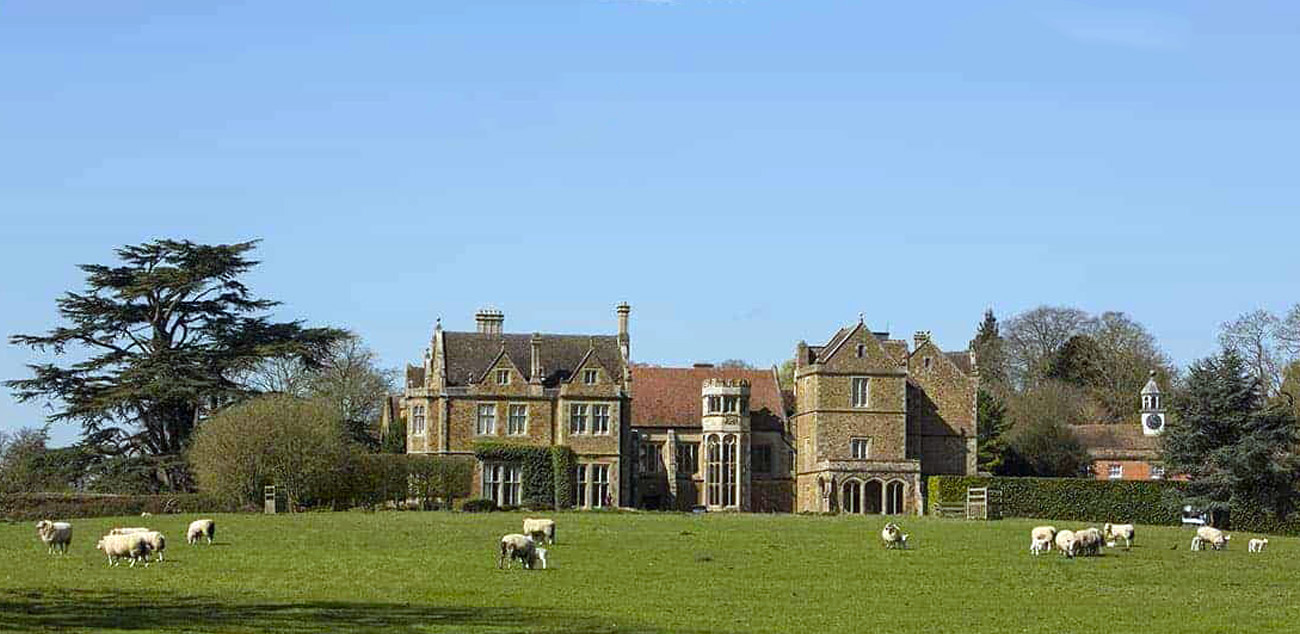
View of Fawsley Hall from the lake (image courtesy of Hand Picked Hotels)
THE KNIGHTLEY FAMILY
The Knightleys arrived in England with William the Conqueror and settled in the village of Knightley in Staffordshire, from whence the name comes. Eventually, the Knightleys would become the senior armorial family of Northamptonshire. Richard Knightley (d. 1442/3) (RKI) of Burgh Hall, Stafford, purchased the Fawsley estate ca. 1316 as well as those of Upton and Hellidon. In 1394 Richard served in Parliament as ‘Knight of the Shire’, acquiring the Lord of the Manor of Fawsley in 1416 from Geoffrey Somerton, he married Elizabeth, the daughter of Thomas Purefory of Drayton, Leicestershire in 1420. He was a successful Staffordshire lawyer and he became the King’s Sargeant and Tellor of the Exchequer.
The family developed sheep farming at the expense of their peasant tenants, who all came to be evicted by the turn of the 15th century. Richard Knightley’s son, also Richard (d. 1476) (RKII), was three times sheriff and succeeded to the estate on his mother’s death in 1474, built the first wing of the present house. He married Eleanor, daughter of John Throgmorton of Coughton, and was knighted by Henry VII in 1494. They had nine children, of whom the eldest, Richard (1455-1534) (RKIII) married Joan Skenard or Skimerton, daughter and heir of Henry Skenard of Alderton. She brought in a great number of quarterings which are still included in the Knightley family shield. They are buried in an altar tomb in Fawsley church.
The Tudors
Richard’s brother, Edmund (d. 1543) inherited thereafter and was knighted by Henry VIII in 1542. Sir Edmund, a sergeant-at-law, enhanced the family wealth being appointed a commissioner for the suppression of the monasteries and confiscating monastic lands. Edmund held strong religious convictions, once trying to prevent Henry VIII from taking the son of his deceased brother in law (Sir William Spencer) into wardship. He was thrown into London’s Fleet Prison for his impudence. Sir Edmund married Ursula, daughter of Sir George Vere, one of the sisters and co-heirs of John Vere, Earl of Oxford. A brass in Fawsley church depicts her by the side of her second husband, Edmund, though she is buried in Letheringham church, Suffolk through the connection of her sister, Elizabeth Wingfield.
By now Fawsley was a large estate, Sir Edmund built the great Hall at Fawsley, and the two-storied oriel window. He died in 1543, they had six daughters, all of whom died young, so that Fawsley was inherited by his brother Valentine (1495-1566) (VKI) Sir Valentine married Anne, daughter of Sir Edward Ferrers of Baddesley Clinton, Co. Warwickshire. Their eldest son, Sir Richard (1533-1615) (RKIV) succeeded his father in 1556 and was knighted in 1565, and proved to be one of the most interesting members of the family. He was commanded by Elizabeth I to be present at the execution of Mary Queen of Scotts at Fotheringhay Castle, in Northamptonshire. Richard also entertained Queen Elizabeth I in 1575 in the south wing at Fawsley. In an inventory of a Knightley family member who died in 1650, there is a mention of the ‘Queens Chamber’. Today this is the hotel’s 1575 suite. Queen Elizabeth I often visited her courtiers during the summer months while her palaces were being cleaned. Richard was MP for Northampton in 1584 and 1586, and for Northamptonshire in 1589 and 1598.

Edmund Knightley (d. 1543) and his wife Ursula, Church of St. Mary the Virgin, Fawsley Park

LEFT: Attributed to Hans Eworth, Portrait of Sir Richard Knightley (1533-1615) (RKIV), aged 33
RIGHT: English School, Portrait of Lady Elizabeth Knightley (Richard’s second wife)
(Coll. Firle Place, East Sussex)
THE PURITANS AND THE CIVIL WAR
The Knightleys were Puritans, married into such families as the Hampdens and Lucys of Charlecote. Sir Richard (RKIV) was a conspicuous member of the Puritan faction in Parliament, rebelled against the Star Chamber’s measures to stop the free circulation of Puritan pamphlets. Richard Waldegrave, a printer well-known for his mobile printing press, and the Puritan preacher and pamphleteer John Penry in the late 1588 and early 1589 responsible for producing the first four notorious tracts – very hostile pamphlets attacking the Elizabethan Bishops for hindering religious change – apparently written by an unknown satirist using the pseudonym, Martin Marprelate.
The first of the tracts, Martin’s Epistle was printed on a secret press at Elizabeth Hussey’s home at East Mosley, Surrey in October 1588. It enjoyed immense popularity, and the ecclesiastical authorities instigated a hue and cry after Martin. In November the press was moved from East Molesey to Sir Richard Knightley’s house at Fawsley, where Martin’s second tract, The Epitome, was printed. Shortly thereafter the secret press was moved to the Whitefriars, Coventry, the home of Knightley’s great-nephew, John Hales, where Certaine Minerall and Metaphysicall Schoolpoints and Hay Any Worke for Cooper were printed, the former in early January and the latter in late March 1589. Thereafter the press was moved to Wolston Priory in Warwickshire, home of Roger Wigston. Sir Richard was imprisoned for allowing the printing of Puritan material, also there is little doubt that in the period leading up to the Civil War, the Knightleys were very much opposed to the unlimited power of royalty. The term ‘sub rosa’ is supposed to have originated from the flower in the centre of the ceiling of the bay window to the Great Hall, above which is the secret room where meetings were held. On the eve of the Battle of Naseby, Charles I was seen hunting deer in Fawsley Park. This may seem curious seeing as the Knightley’s were Parliamentarians but the Knightley family had leased out the house and were living in London at the time. Clearly the tenants were Royalists!
Richard’s son, Sir Valentine Knightley (c. 1555-1618) (VKII) succeeded to Fawsley, though he died three years after his father. Valentine married Anne, daughter of Sir Richard Unton of Wadley, Berkshire with whom he had a son (who pre-deceased him) and three daughters. Fawsley then passed to his nephew Richard Knightley (1593-1639) (RKV) of Preston Capes, the son of Edward. He too was a staunch Puritan and MP, joining the obstinate opponents of the court. His shrievalty of Northamptonshire in 1626 is said to have been due to the King’s desire to keep him from Westminster. He married Bridget, daughter of Sir Thomas Lucy of Charlecote, Warwickshire. They had no children so that upon his death, he was succeeded by his cousin Richard Knightley (1580-1650) (RKVI) of Burgh Hall, Staffordshire who married the daughter of John Compton, and sat in the Short Parliament and the Long. At the coronation of Charles II, he was appointed a Knight of Bath.
THE GEORGIANS, VICTORIANS AND EDWARDIANS
After a century of long minorities and premature deaths, Lucy Knightley (d. 1791) (a male) inherited Fawsley in 1728 and added the Georgian wing in the classical style. To the north of the house is an elegant Georgian stable block with a simple cupola on its roof. The family represented Northamptonshire in Parliament through the 18thcentury and in 1798 Sir John Knightley, 22nd Lord of the Manor (1746/7 – 1812), was made the first baronet. Building continued under his nephew, Sir Charles Knightley, 2nd baronet (1781-1864) (CKI) who carried out the Gothic alternations to the Georgian wing, a typical country gentleman, he farmed his own land, brewed his own ale and reared a famous breed of cattle known as the Knightley shorthorns. His wife, Selina Mary Hervey, granddaughter of the first Earl of Bristol, had died in 1856, their only daughter, Sophia Selina or Sophy, married Henry Edward Gage in 1840, they made their home at Fawsley for part of the year, together with their son, Harry. Sophy and Henry’s daughter, Selina Elizabeth married Henry Cavendish of Chycknell, Shropshire in 1862. They were divorced in 1872, their three daughters, Edith, Ethel and Elfreda often stayed at Firle Place, which at this time acted as a family hotel. Subsequently Selina Elizabeth married J. White of Westbank, Fifeshire.
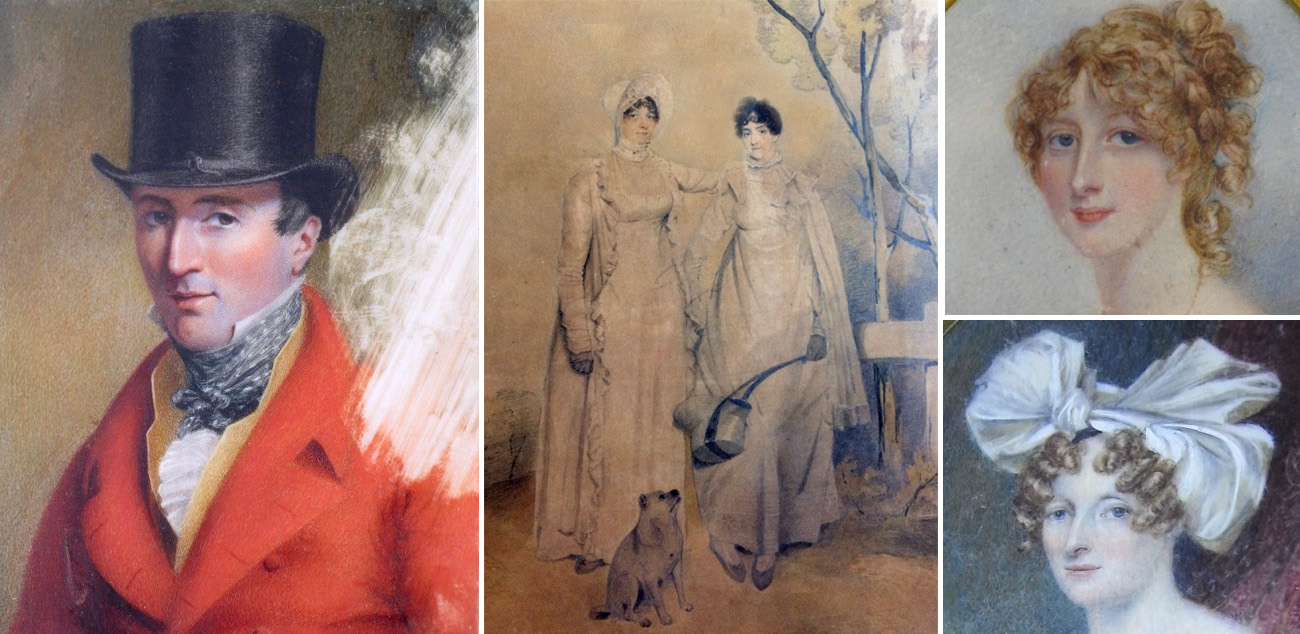
LEFT: Sir Charles Knightley (1781-1864) (CK1)
CENTRE: Selina Mary with her sister, Selina Mary married Sir Charles Knightley
RIGHT-TOP: Anne Mee (British 1770-1851) Lady Knightley (nee Selina Mary Hervey)
RIGHT- BOTTOM: Mrs S S Gent (nee Daniel) Lady Knightley (nee Selina Mary Hervey)
(Coll. Firle Place, East Sussex)

LEFT: British School – Rainald, 1st Baron Knightley (1819-1895) (Coll. Firle Place, E. Sussex)
CENTRE: Lady Knightley 1869, Louisa married Rainald, 1st Baron Knightley
RIGHT: Lady Knightley c. 1910
When Sir Charles died in 1864, Fawsley Hall was shut up, so Sophy and Henry gravitated towards Firle Place, living there with his father, the 4th Viscount Gage(1791-1877). Sir Charles’s son, Sir Rainald, third baronet (1842-1913) felt that it was incumbent on him to marry for the good of his family. He embarked upon an ambitious project to improve the house at Fawlsey and to adapt it to modern requirements. He commissioned Anthony Salvin to re-model a suite of new living-rooms facing south, and an entrance porch was added. Rainald married Louisa Mary Bowater (1842-1913) in 1869. Rainald was MP for south Northamptonshire for 40 years, and Queen Victoria granted him a Life Peerage of Baron Knightley of Fawsley in 1892. Rainald died childless in 1895. His wife Louisa, extra lady in waiting to HRH Duchess of Albany (the Duchess of Albany was the widow of Prince Leopold, the youngest son of Queen Victoria) kept possession of the hall until her death in 1913. The subsequent decline of the family was dramatic. There being insufficient capital for the will to be proved, the contents of the house were auctioned over a three-week period in 1914. Louisa was the last Knightley to live in Fawsley Hall, bringing 500 years of the Knightley legacy to a close. Her diaries, ‘The Journals of Lady Knightley’ provide a vivid account of her life at Fawsley. During this period, Louisa befriended John Merrick, ‘the Elephant Man’, and provided him with a cottage on the estate.
Louisa’s eventual heir, and the penultimate 5th baronet, Sir Charles Valentine (1853-1932) (CKII) died in 1932, he married Lady Juliet, and his brother, the Rev. Sir Henry Francis, (1854-1938) 6th and last baronet died in 1938: both without heirs and had lived in the Stewards House. Because of the marriage of Rainald Knightley’s sister, Sophia Selina (1816-86), to the Hon. Henry Edward Gage (1814-1875), Louisa’s great-nephew, Henry Rainald, 6th Viscount Gage (1895-1982) of Firle Place, Sussex in turn inherited Fawlsey.
The Hon. Henry Edward pre-deceased his father, Henry Hall, 4th Viscount Gage (1791-1877) thus he never inherited the Gage title, though Sophia continued living at Firle after his death, helping their son, Henry Charles Gage, 5th Viscount Gage (1854-1912) run the household until her death in 1886. He married Leila Peel in 1894.
While Fawsley Hall was sold in 1975, the Gage family still own the land of the former Knightley Estate.

LEFT: John St. Helier Lander – Portrait of Henry Rainald, 6th Viscount Gage, dated 1933, who inherited Fawsley from his great aunt, Lady Louisa Knightley in 1938 (Coll. Firle Place)
RIGHT: Sign at the entrance to Fawsley Park
FAWSLEY HALL
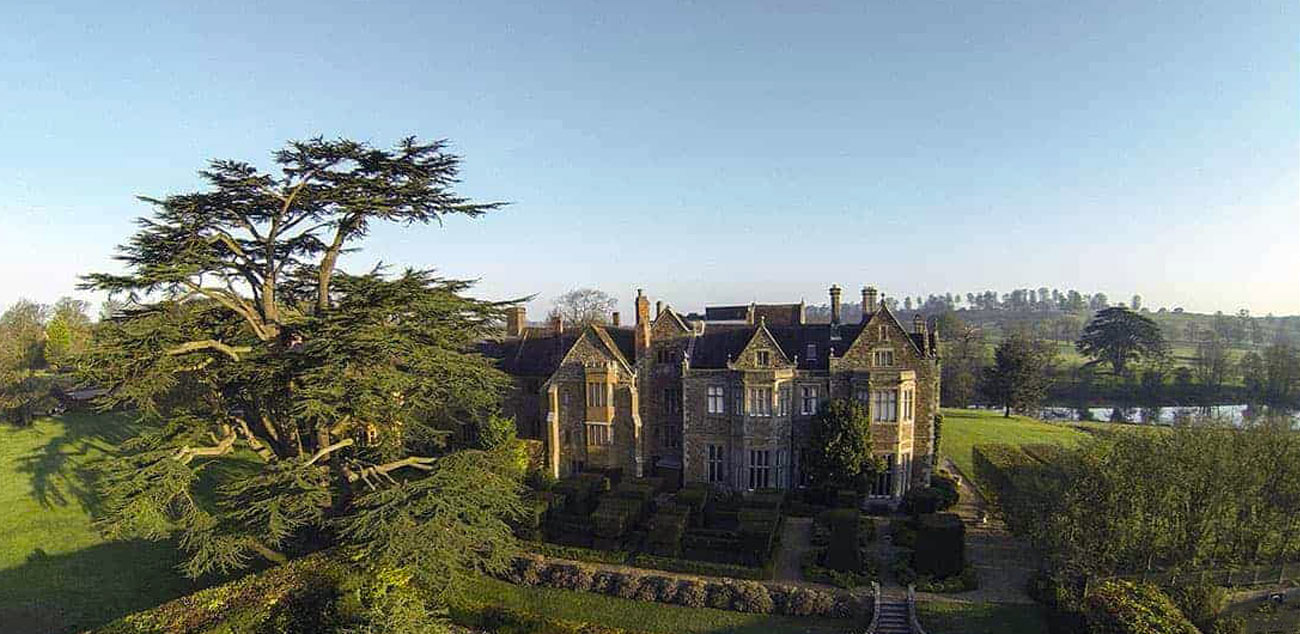
Fawsley Hall (image courtesy of Hand Picked Hotels)
The Hall (listed Grade I) is partly of the 16th century and partly of 1867/8, today is a five-bay hall, a south-facing parlour with two-storied oriel, the kitchen and bakehouse west of the parlour, and the long range known as the brewhouse which runs parallel with the hall range, from the bakehouse to the north. It is of coursed, square limestone, with limestone dressings. The fourth, north side of the inner court is closed by a range dated 1732 and attributed to Francis Smith of Warwick (d. 1738) but altered by Thomas Cundy (d. 1825) in 1815 and then extended by Anthony Salvin (d. 1881) in 1867/9 into a three-story range.
The earliest part of the house is the Tudor south wing built by Richard Knightley (d. 1534) (RKIII) in the early 16th century. The hotel restaurant now occupies most of the ground floor of the south wing. The early house is exceptional in that it contains two kitchens, each having a large back fireplace served by a common chimney. Above the kitchen, which has a door opening into the courtyard, is the room in which Elizabeth I slept during her visit in 1575. Following the completion of the South Wing, three further wings were soon added. These were the Great Hall, Brew House and the Gate House thereby forming an inner courtyard.
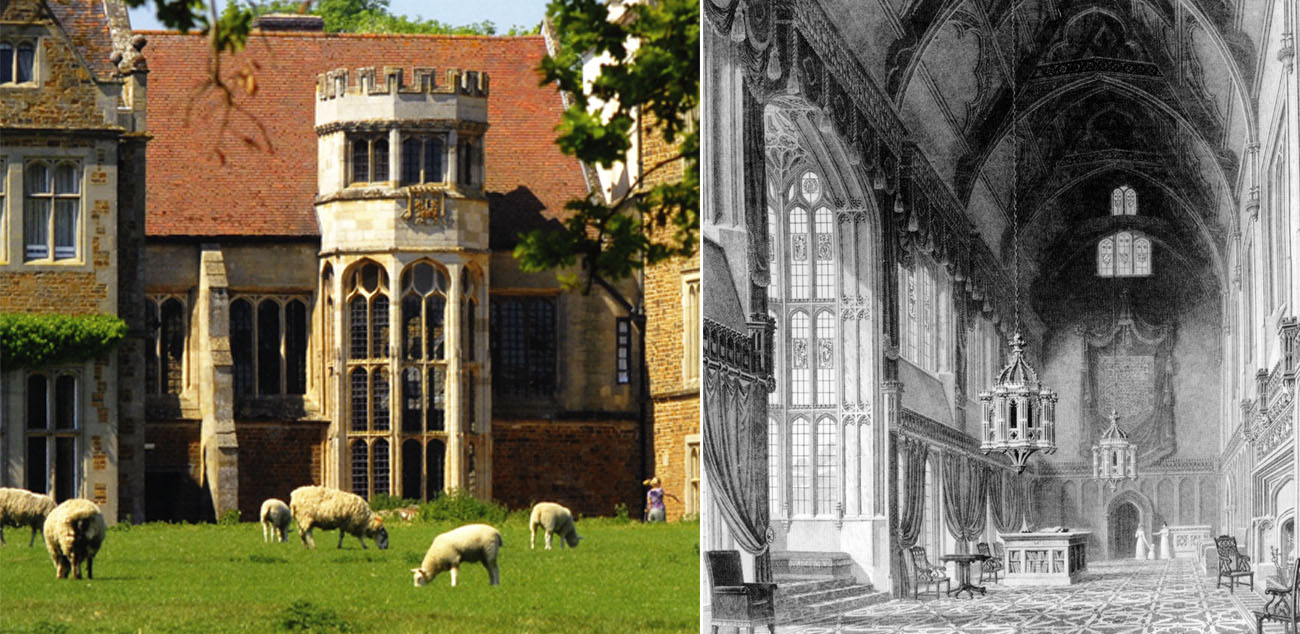
LEFT: The Great Hall at Fawsley Hall
RIGHT: Interior of the Great Hall c. 1830

View of Fawsley Hall from the drive
GREAT HALL
Sir Edmund Knightley (d. 1543) commissioned the building of the Great Hall in 1537 in the traditional open hall style of the period. Its fine roof was removed in 1966 but was reconstructed in 1988 using an engraving from 1816 and a few surviving beams. These original beams are of much darker wood than the new beams. As you face the original Tudor fireplace you can see the coat of arms of the Knightleys and those of Richard I and twenty-six knights who accompanied him on his first crusade. The fireplace itself is slightly smaller than it was originally. There was a large window with three lights above the fireplace with the smoke being carried by twin flues either side of the windows. The flues are still there but the three windows were covered over to allow the construction of a central flue.
On high are copies of the original stained-glass panels, now in the Burrell Collection in Glasgow. The large aperture in the end wall to the right was originally a squint allowing observation by servants. Immediately facing the fireplace is the large bay window with its fine carved ceiling. Above that ceiling, now inaccessible, is a hidden room, commonly thought to be the place where Puritan ‘Marprelate tracts’ were secretly printed in 1558 during the tenure of Sir Richard Knightley (RKIV). It was reached originally by a spiral staircase outside, where the outline of the entrance archway can still be seen. The family crest can also be seen above the window outside. Curiously, the crest and coat of arms has not fallen over, for some unknown reason it is displayed on its side. The large shield in the Great Hall on the left by the bay window contains 334 quarterings of heraldry showing all the Knightley marriage alliances up to the 19th century.
THE WEST WING OR BREW HOUSE
This was built around the same time as the Great Hall. Today the hotel bar and lounge are located on the ground floor of this wing. It is constructed of golden Northamptonshire sandstone and contains the very fine oriole window on the upper floor at the north end. Not only was brewing carried out here but also the laundry and a possible dairy. It was the very first part of the house to be restored in 1976.
GEORGIAN NORTH WING
When he inherited Fawsley, Lucy Knightley (1742-1791) demolished he original gatehouse and north wing, and commissioned another wing. It is constructed at an angle which is not symmetrical with the rest of the house, possibly due to boundary constraints. It has been attributed to Francis Smith of Warwick. The main addition to the house comprised three new storeys, topped with a balustraded parapet. In 1815 Sir Charles Knightley, 2nd baronet (1781-1864), commissioned Thomas Cundy to remodel it in Gothic style, which included demolishing part of the eastern end and replacing it with three floors and a single storey porch for the new main entrance, but at a modest cost. Corner turrets were added at the top with battlements replacing the parapet. Not to be outdone, his son Rainald 3rd baronet (1819-95) commissioned Anthony Salvin for a further re-modelling of the wing in 1868. He removed the battlement turrets and porch and replaced them with another porch large enough for coaches to pass through.
VICTORIAN AND SOUTH EAST WING
In preparation for the wedding of Sir Rainald (later) Baron Knightley (1819-95) to Louisa Mary Bowater (1842-1913), Anthony Salvin was commissioned between 1866 to 1868 to demolish the south-east corner of the house and to build a new range of ground floor public rooms, bedrooms and attic servants’ quarters and remodeled the north range and the Great Hall, in the Tudor revival style. These are now the hotel’s main function rooms. The total cost was £13,300 and Rainald’s extravagance was to prove a costly mistake for decades to come.
COURTYARD
This was covered over in the 19th century and divided into rooms with inter-connecting passages which were lit by sky lights. Traces of this construction can still be seen on the surrounding walls in the courtyard.
THE 20TH CENTURY
After the auction of its contents in 1914, the house was requisitioned by the army during the First World War and afterwards only a skeleton staff lived there. The Gage family who inherited the house in 1932 already had a family seat in Sussex and had no need for another one. The future of Fawsley was uncertain. It was again requisitioned in the Second World War, and in the 1950s and 60s a timber company leased the building as a workshop. Further deterioration occurred following the departure of the timber company. Its sorry state was highlighted when Fawsley Hall was featured in an exhibition at the Victoria and Albert Museum, entitled ‘The Decline of the English Country House’. In 1975 it was purchased by successful entrepreneurs and antique dealers, Mr. and Mrs. E.A. Saunders. The monumental task of restoring the house continued until the recession of the late 1980s. Work started again in 1996 when a consortium, including the Saunders, reinvested in the building and created the superb hotel that it is today.
North of the Hall is an early 18th century U-plan red-brick stables court (listed Grade II) attributed to Francis Smith, and converted into the hotel spa today. The piers of the main gate against the north-east corner of the stables are late 17thcentury (listed Grade II). West of the stables is the 18th century Coach House (listed grade II), converted into a house in the 20th century.
We would like to acknowledge our thanks to Fawsley Hall Hotel, part of the Hand Picked Hotels group who have allowed us to quote from their historical notes. For those interested in visiting Fawsley Hall, in its magical setting overlooking Fawsley Park, we would highly recommend a stay, or looking in for an excellent meal, details may be found on the following link : www.fawsleyhall.com, or by telephoning +44 (0)1327 892000.
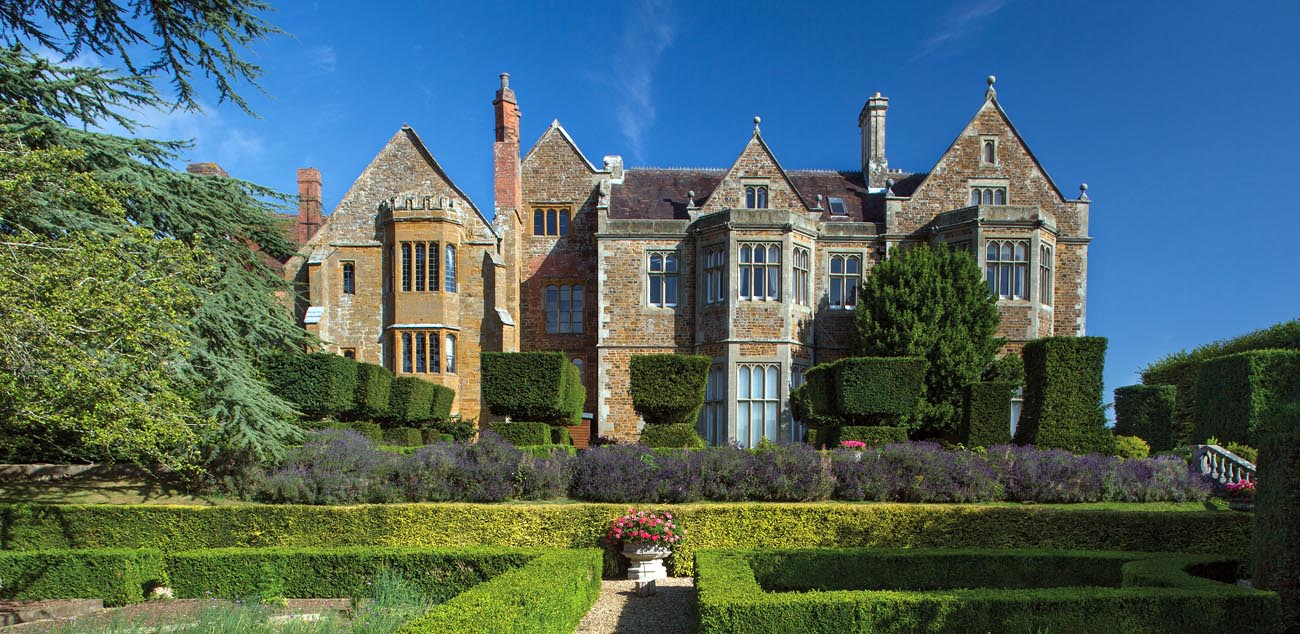
Fawsley Hall garden front (image courtesy of Hand Picked Hotels)
THE BRICK WALLED GARDEN

The Brick Walled Kitchen Garden at Fawsley Hall (shortly after renovation)
The brick-walled sloping kitchen gardens lie 300 metres west of Fawsley Hall, which is recorded in 1741. The complex includes a hip-roofed gardner’s house, probably mid-18th century and to either side there are brick sheds from the 18th and 19thcenturies. The garden and buildings had become completely overgrown and fallen into ruins, until miraculously it was restored in 2014, it was the first walled garden in the country to be part funded by Natural England’s Higher Level Stewardship Scheme (HLS), as an integral part of overall Grade II* listed landscape at Fawsley.
The Park

Fawsley Park in early Spring
In the 1760s and 70s Lancelot ‘Capability’ Brown, the landscape gardener, was engaged by Lucy Knightley and transformed the park by damming one of the lakes and creating sweeping vistas, planting trees and laying lawns. Many of the trees can still be seen today. Diarist Horace Walpole noted that Brown was at Fawsley in 1763. His account books show that he was paid £700 (almost the equivalent of £1.2 million in 2015) in 1765-66. There was a second contract in 1767-68 for £550 (or the equivalent of £938,400 in 2015). The park occupies most of the central and northern parts of the parish, and is separated from the Hall by a U-plan arrangement of lakes. The main lake, Big Waters, curves round to the east of the church. Big Waters adjoins The Canal, the long, triangular lake south of the Hall. North of the Hall is a corresponding triangular lake, Horse Pond.

LEFT: View across to Fawsley Hall from the lake (image courtesy of Hand Picked Hotels)
RIGHT: One of the radiating rides at Hazley Knob
The northern section of the park is occupied by Bradbury Wood. At the centre of the wood, and forming the focus of radiating rides, is Hazley Knob. Most of the park to the south is permanent pasture with mature parkland trees. Ridge and furrow survive under all the park’s permanent grassland; ploughing last occurred between the 15th and 18th centuries.
THE CHURCH OF ST MARY THE VIRGIN, FAWSLEY PARK
One of the main views from Fawsley Hall is from the ha-ha to the isolated medieval Church of St. Mary (Grade 1 listed) in the park, the present building was erected ca. 1209. The church was founded by John de Fawesle (Fawsley), the first recorded vicar, and comprises the west tower, nave (with two aisles), south porch and chancel. The tower, dating from the early 13th century, is built in the Decorated style of architecture and has four Y shaped bell openings and several corbels around the parapet. These take the form of animal heads.
The tower contains a ring of four bells which were all thought to have been cast by Messrs. Chamberlain, bell founders of London, in the 1450s. Box pews are a feature of the church and they contain medieval carved panels, which give some insight into the domestic beliefs and attitudes of the worshippers at the time. In the south aisle is the spacious Knightley pew, this enabled the family to be ‘hidden’ from the rest of the congregation, the family could look through the squint in the south wall of the chancel, to see the altar. The main glories of St, Mary’s are its magnificent monuments, memorials and hatchments to the Knightley family, including a sculpture of 1856 in the south aisle by John Gibson of Rome to Sophia Selina Knightley (1816-86), showing her being received by an angel. However, the church’s most distinguished treasure is its splendid collection of medieval stained glass. The oldest glass is in the vestry, depicting Adam and Eve in the Garden of Eden, probably dating from the 13th century. The east window of the north aisle houses the famous glass of the Washington family consisting six heraldic shields depicting the family’s coat of arms: these are quartered with the families into which they married. The glass, brought from Sulgrave in 1830, is of particular interest because it clearly shows the Washington coat of arms upon which the American flag, the ‘Stars and Stripes’, is undoubted based.
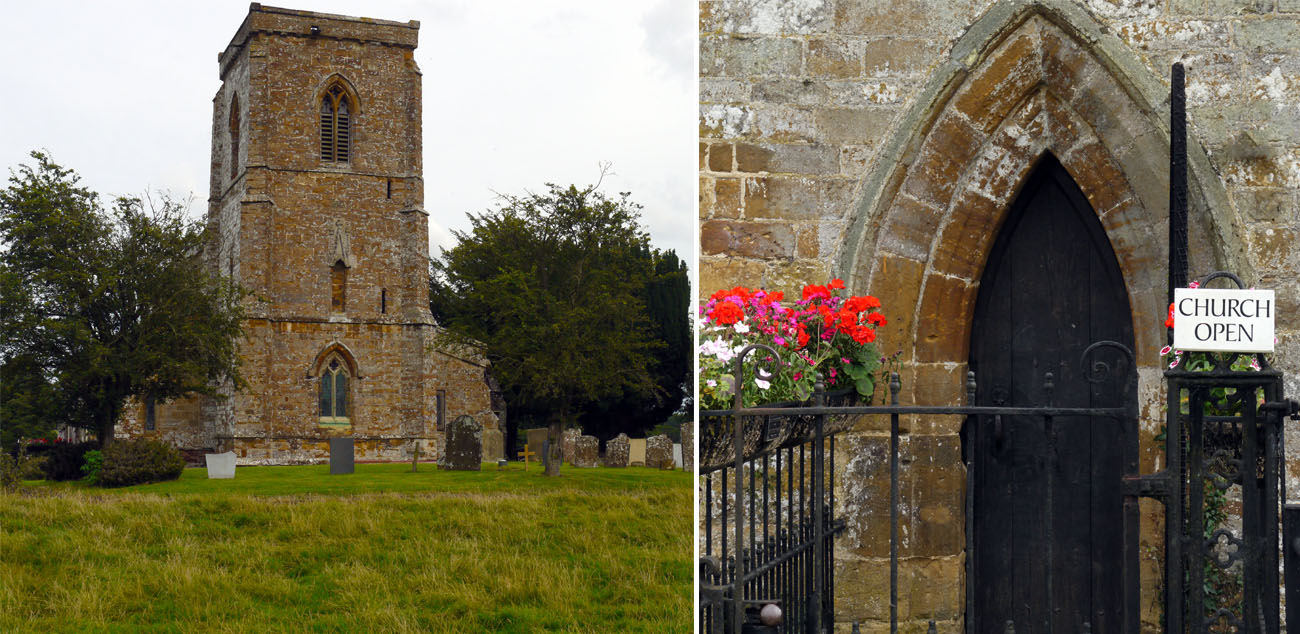
The Church of St Mary the Virgin, Fawsley Park
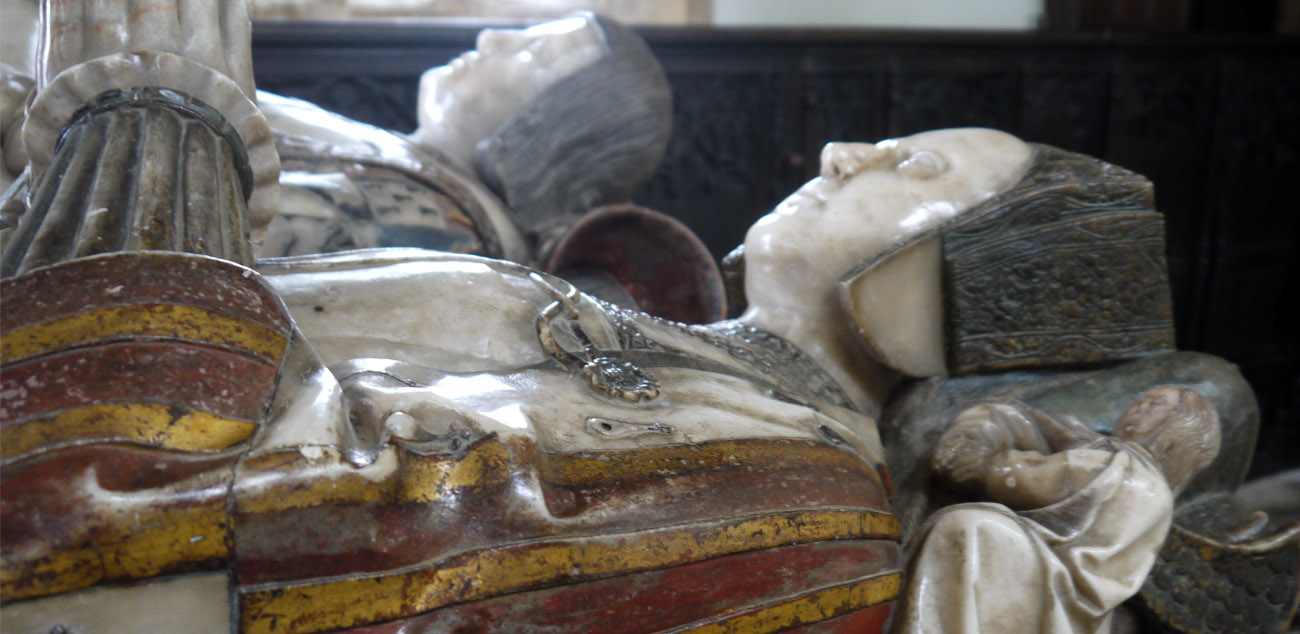
Tomb Richard Knightley (d. 1476) and his wife Eleanor, St. Mary Church the Virgin, Fawsley
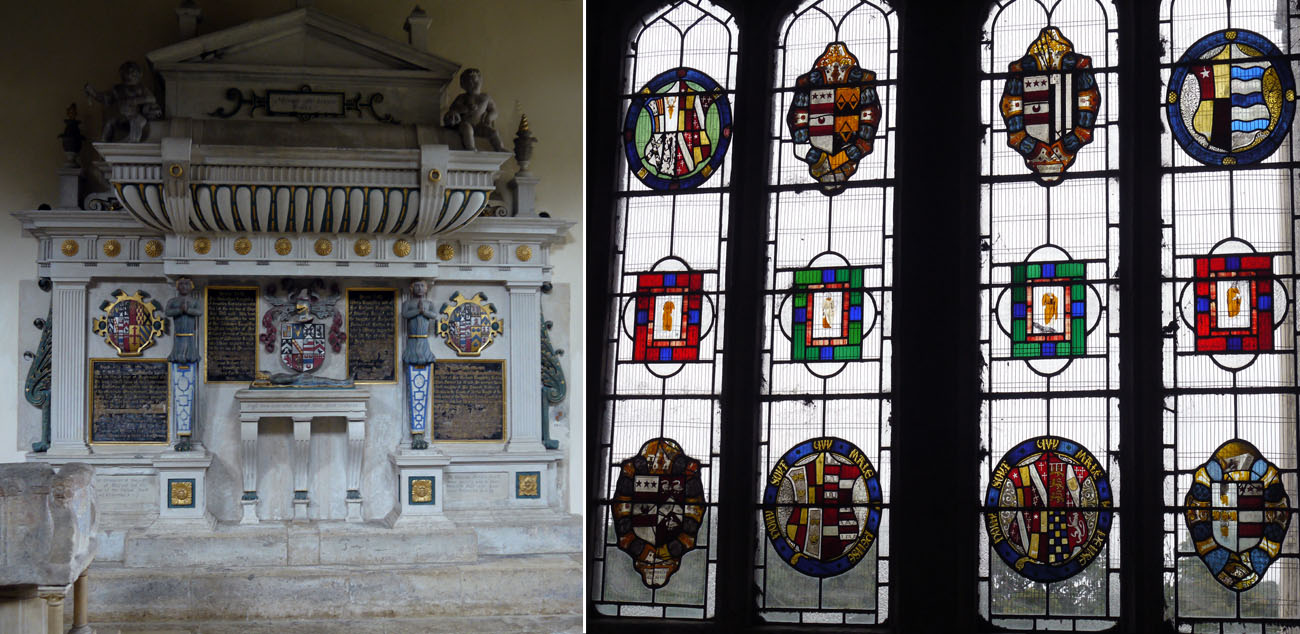
The Knightley Tomb and Washington windows, St. Mary the Virgin, Fawsley
THE DIARIES OF LADY KNIGHTLEY (1842-1913): LINKS BETWEEN THE GAGE AND KNIGHTLEY FAMILIES
On March 29, 1869 Louisa Mary Bowater (1842-1913) had been a bridesmaid at the marriage of her friend, Lady Julia Melville to General Robertson in Roehampton, she then paid a visit to Sussex, Louisa records in her diary: ‘Firle Place, Lewes, Tuesday, March 30, 1869 – We left home early and went up to London Bridge, whence we had a charming trajet through very pretty country, to this delightfully quaint old place at the foot of the Downs – a great rambling house with a central courtyard, a splendid hall and fine picture gallery. Most agreeable small party – our kind host and hostess, Mr. and Mrs. Gage, her brother, Sir Rainald Knightley and Sir Thomas Munro, two exceedingly pleasant men, with whom I thoroughly enjoy mental trotting out.’ The son of Henry Hall, 4th Viscount Gage (1791-1877) and his wife Elizabeth Foley, The Hon. Henry Edward Gage (1814-75) had married Sophia Selina (1816-86), the sister of Sir Rainald Knighley, (1819-95) 3rd baronet of Fawsley Hall, who was also staying at Firle. It was, Louisa recorded ‘A days to be kept for all time’. Rainald was almost 50 and Louisa 27. Three days later she recorded ‘I had much talk with Sir Rainald. I wonder if I begin to understand him? He strikes as a very good average sort of man: clever without being a genius; good without having a very high standard – in short, not unlike myself.’ He had been M.P. for South Northamptonshire since 1852, when he inherited the seat from his father, Sir Charles, who had himself represented the Division for 18 years. Rainald was the twelfth member of the family to have sat as Member of Parliament since Robertus de Knyghteleye in 1325. Sir Charles had been a renowned horseman and had given his name to Knightley’s Leap just below Brixwood Hill after clearing a fence and a brook some 31 feet in width. Rainald was an equally skilled rider with the Pychley and Grafton Hounds, and Louisa joined him in the field. Rainald was enormously proud of his ancestry – the achievement hanging at the end of the Great Hall at Fawsley had 334 quarterings.
Louisa and Rainald met on a number of occasions during June and July 1869 in London, Sir Rainald came with his sister, Mrs. Gage, to a large croquet party, and invited Louisa and her mother to pay a visit to Fawsley during the second week in August. Louisa recorded in her diary on July 17th ‘that probably the greatest event in my life will be decided in less than a month.’ On the 13th of August Louisa writes ‘No, I can’t write any description of today, but I have plighted my troth to Rainald Knightley, and from the very bottom of my heart I pray God that he will help me to be a good wife to him. He is so good to me. I am sure we will be very happy together. It was all settled coming out of the dear little church here, which Rainald took me to see this morning.’ Rainald and Louisa were married on 20 October, 1869 at St. Peter’s, Eaton Square, London. They were to spend the rest of their lives at Fawlsey. On 20 October, 1870 Louisa wrote to her mother, ‘One thing I am quite sure of – that no two people, at the close of a year of married life, can look back with more unalloyed happiness than we do. One thing is still wanting to complete it – but that we must leave in God’s hands.’ Like many other Knghtley’s before them, however, there were no children to the marriage.
For their first Christmas at Fawsley, Louisa records in her diary on December 23rd, 1869 ‘In the afternoon arrived Sophy and Henry Gage and their boy Harry’.
Easter 1870 was spent in Sussex, described by Louisa: ‘Firle, Easter Day, April 16 – All together – dear little Harry for the first time – we knelt together in the primrose-decked church to receive Holy Communion, dearest Rainald remembering how last Easter Day he had prayed that he might find the right wife; so that we may humbly hope our happiness is even more than in the common sense God-given.
….All these days have been most enjoyable, the brightest sun, the bluest sky, tempting one to be out the whole day, doing nothing but read and play croquet. A very bright and sunny bit of life…. We left Firle with much regret after a very happy week.’

LEFT: Louisa Mary Bowater
RIGHT: Sir Rainald Knightley

LEFT: Sir Charles William Ross RA (1794-1860) Lady Bowater nee Emilia Mary Barnes c. 1846, mother of Lady Louisa Knightley
CENTRE: Robert Thorburn (1818-1885) Sophia Selina Knightley, who married the Hon.Henry Gage – Oil on copper
RIGHT: Sophia Selina Gage (Coll. Firle Place, East Sussex)
Thereafter Louisa’s diaries are sprinkled with references to a round of family to-ings and fro-ings between Fawsley, London and Sussex. Both Louisa and Rainald visited Firle Place frequently, and always wistful when it came time to leave. As Rainald’s sister, Sophia Selina, and her husband Henry Gage, had no home of their own, they lived part of the time at Fawsley, partly at the Gage London home 4 Whitehall Yard, and partly at Firle – Selina’s Ante Room with the floral border decoration she created around the walls remains at Firle today. In her later years Louisa often attended family events at Firle, and was delighted when the future 6th Viscount Gage was given the name of Rainald, who would subsequently inherit Fawsley. As Rainald Knightley suffered from frequent bouts of gout and rheumatism, he had been advised by his doctor to drink the waters and take the baths at Homburg and Wildbad. Homburg was particularly popular with the English and Louisa and Rainald, together with the Gages often stayed there at the end of the London season.

House party, Firle Place,1900, Lady Knightley is seated in the front row, second from the right
In addition to the Knightley family genealogy, Louisa also took a keen interest in the Gage family. Her diary on October 16, 1898 records her correspondence with her great-nephew, Moreton Foley Gage (1873-1953) son of Edward Thomas Gage (1825-1889) and grandson of Henry Hall, 4th Viscount Gage relating to the exploration of the White Nile and the Fashoda Incident. Or in Hengrave Hall, Suffolk which had descended through another branch of the family from the 17th century, which she visited on 11 July, 1896: ‘To Hengrave, the old Gage place of which I have heard so much and once went to the door from Ickworth. The doorway is most striking with the fine shield round the window and the great oaken door below. Inside the house is not specially remarkable having been much pulled about and spoiled and a fine old hall cut up with small rooms. But is full of beautiful furniture of every date and a good many interesting pictures, a Holbein of the founder, Sir Thomas Kyston, two or three of lady Penelope, the lady of three husbands, a very good one of one of them, Sir John Gage…..The house was sold soon after the death of Lady Rookwode Gage, widow of the last baronet, is for sale just as it stands, but though it is full of interest I think I would rather see it than live in it.’
The social milieu of the time was small, on February 27, 1872 Louisa records attending a service of Thanksgiving at St. Paul’s Cathedral for the Prince of Wales, Prince Leo’s recovery and sitting opposite ‘Lady Bath, Lady Cowper and Lady Brownslow – to my mind three of the lovliest of women’. Emily Cowper was married to the 5th Earl Cowper, they lived at Panshanger in Hertfordshire – another link that would connect with the Gage family in the 20th century through Ettie Desborough and her daughter Imogen, she married the 6th Viscount Gage who inherited Fawsley. Another co-incidence, in his great canvas, Tribuna of the Uffizzi, (Royal Collection) 1772-7, Johan Zoffany chose to depict Valentine Knightley (1744-1796) (VKIII) visiting Florence on his Grand Tour in April 1773, among the cognoscenti. Valentine is dashingly dressed in grey admiring the sculpture of The Satyr with Cymbals, while a short distance away, the celebrated collector, the 3rd Earl Cowper is shown admiring Raphael’s Niccolini Madonna, being shown to him by the artist himself, and subsequently acquired.
The family cycle life is also recorded in Louisa’s diaries, while in Paris in September 1875 she learned of the death of Henry Gage from a newspaper report. Besides feeling deep grief and sympathy for her widowed sister-in-law, Lady Knightley had ‘an affectionate regard for Mr. Gage, who had been her first friend in the family, and to whom, humanly speaking, she owed the chief happiness of her life.’ Of course, it was on a visit to Firle with her mother in March 1869 that Louisa had met Rainald Knightley. Two years later, in August 1877 the Knightley’s spent the month as usual at Homberg, accompanied as usual by Mrs. Gage (Sophia Selina) and her son, ‘who had lately succeeded to the peerage on the death of his grandfather, Lord Gage’, and so became Henry Charles Gage, 5th Viscount Gage (1854-1912).
We wish to acknowledge with many thanks the notes taken from the following publications:
The Journals of Lady Knightley of Fawsley, 1856-1884, edited by Julia Cartwright (Mrs. Ady), 1915;
Politics and Society: The Journals of Lady Knightley of Fawsley, 1885-1912, edited by Peter Gordon, 1999

